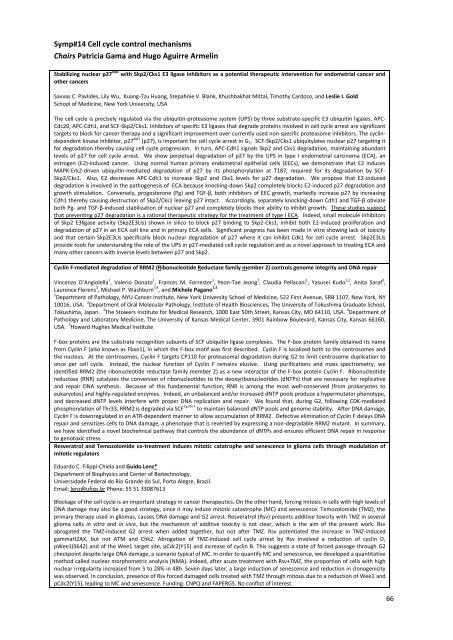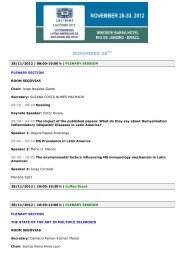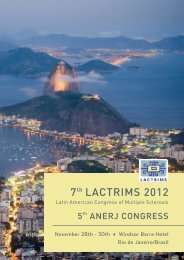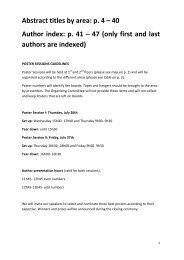Keynote Conference - Interevent
Keynote Conference - Interevent
Keynote Conference - Interevent
You also want an ePaper? Increase the reach of your titles
YUMPU automatically turns print PDFs into web optimized ePapers that Google loves.
Symp#14 Cell cycle control mechanisms<br />
Chairs Patricia Gama and Hugo Aguirre Armelin<br />
Stabilizing nuclear p27 kip1 with Skp2/Cks1 E3 ligase inhibitors as a potential therapeutic intervention for endometrial cancer and<br />
other cancers<br />
Savvas C. Pavlides, Lily Wu, Kuang-Tzu Huang, Stepahnie V. Blank, Khushbakhat Mittal, Timothy Cardozo, and Leslie I. Gold<br />
School of Medicine, New York University, USA<br />
The cell cycle is precisely regulated via the ubiquitin-proteasome system (UPS) by three substrate-specific E3 ubiquitin ligases, APC-<br />
Cdc20, APC-Cdh1, and SCF-Skp2/Cks1. Inhibitors of specific E3 ligases that degrade proteins involved in cell cycle arrest are significant<br />
targets to block for cancer therapy and a significant improvement over currently used non-specific proteasome inhibitors. The cyclindependent<br />
kinase inhibitor, p27 kip1 (p27), is important for cell cycle arrest in G1. SCF-Skp2/Cks1 ubiquitylates nuclear p27 targeting it<br />
for degradation thereby causing cell cycle progression. In turn, APC-Cdh1 signals Skp2 and Cks1 degradation, maintaining abundant<br />
levels of p27 for cell cycle arrest. We show perpetual degradation of p27 by the UPS in type I endometrial carcinoma (ECA), an<br />
estrogen (E2)-induced cancer. Using normal human primary endometrial epithelial cells (EECs), we demonstrate that E2 induces<br />
MAPK-Erk2-driven ubiquitin-mediated degradation of p27 by its phosphorylation at T187, required for its degradation by SCF-<br />
Skp2/Cks1. Also, E2 decreases APC-Cdh1 to increase Skp2 and Cks1 levels for p27 degradation. We propose that E2-induced<br />
degradation is involved in the pathogenesis of ECA because knocking-down Skp2 completely blocks E2-induced p27 degradation and<br />
growth stimulation. Conversely, progesterone (Pg) and TGF-β, both inhibitors of EEC growth, markedly increase p27 by increasing<br />
Cdh1 thereby causing destruction of Skp2/Cks1 leaving p27 intact. Accordingly, separately knocking-down Cdh1 and TGF-β obviate<br />
both Pg- and TGF-β-induced stabilization of nuclear p27 and completely blocks their ability to inhibit growth. These studies suggest<br />
that preventing p27 degradation is a rational therapeutic strategy for the treatment of type I ECA. Indeed, small molecule inhibitors<br />
of Skp2 E3ligase activity (Skp2E3LIs) shown in silico to block p27 binding to Skp2-Cks1, inhibit both E2-induced proliferation and<br />
degradation of p27 in an ECA cell line and in primary ECA cells. Significant progress has been made in vitro showing lack of toxicity<br />
and that certain Skp2E3LIs specifically block nuclear degradation of p27 where it can inhibit Cdk1 for cell cycle arrest. Skp2E3LIs<br />
provide tools for understanding the role of the UPS in p27-mediated cell cycle regulation and as a novel approach to treating ECA and<br />
many other cancers with inverse levels between p27 and Skp2.<br />
Cyclin F-mediated degradation of RRM2 (Ribonucleotide Reductase family member 2) controls genome integrity and DNA repair<br />
Vincenzo D’Angiolella 1 , Valerio Donato 1 , Frances M. Forrester 1 , Yeon-Tae Jeong 1 , Claudia Pellacani 1 , Yasusei Kudo 1,2 , Anita Saraf 3 ,<br />
Laurence Florens 3 , Michael P. Washburn 3,4 , and Michele Pagano 1,5<br />
1 Department of Pathology, NYU Cancer Institute, New York University School of Medicine, 522 First Avenue, SRB 1107, New York, NY<br />
10016, USA. 2 Department of Oral Molecular Pathology, Institute of Health Biosciences, The University of Tokushima Graduate School,<br />
Tokushima, Japan. 3 The Stowers Institute for Medical Research, 1000 East 50th Street, Kansas City, MO 64110, USA. 4 Department of<br />
Pathology and Laboratory Medicine, The University of Kansas Medical Center, 3901 Rainbow Boulevard, Kansas City, Kansas 66160,<br />
USA. 5 Howard Hughes Medical Institute<br />
F-box proteins are the substrate recognition subunits of SCF ubiquitin ligase complexes. The F-box protein family obtained its name<br />
from Cyclin F (also known as Fbxo1), in which the F-box motif was first described. Cyclin F is localized both to the centrosomes and<br />
the nucleus. At the centrosomes, Cyclin F targets CP110 for proteasomal degradation during G2 to limit centrosome duplication to<br />
once per cell cycle. Instead, the nuclear function of Cyclin F remains elusive. Using purifications and mass spectrometry, we<br />
identified RRM2 (the ribonucleotide reductase family member 2) as a new interactor of the F-box protein Cyclin F. Ribonucleotide<br />
reductase (RNR) catalyzes the conversion of ribonucleotides to the deoxyribonucleotides (dNTPs) that are necessary for replicative<br />
and repair DNA synthesis. Because of this fundamental function, RNR is among the most well-conserved (from prokaryotes to<br />
eukaryotes) and highly-regulated enzymes. Indeed, an unbalanced and/or increased dNTP pools produce a hypermutator phenotype,<br />
and decreased dNTP levels interfere with proper DNA replication and repair. We found that, during G2, following CDK-mediated<br />
phosphorylation of Thr33, RRM2 is degraded via SCF Cyclin F to maintain balanced dNTP pools and genome stability. After DNA damage,<br />
Cyclin F is downregulated in an ATR-dependent manner to allow accumulation of RRM2. Defective elimination of Cyclin F delays DNA<br />
repair and sensitizes cells to DNA damage, a phenotype that is reverted by expressing a non-degradable RRM2 mutant. In summary,<br />
we have identified a novel biochemical pathway that controls the abundance of dNTPs and ensures efficient DNA repair in response<br />
to genotoxic stress.<br />
Resveratrol and Temozolomide co-treatment induces mitotic catatrophe and senescence in glioma cells through modulation of<br />
mitotic regulators<br />
Eduardo C. Filippi-Chiela and Guido Lenz*<br />
Department of Biophysics and Center of Biotechnology,<br />
Universidade Federal do Rio Grande do Sul, Porto Alegre, Brazil.<br />
Email: lenz@ufrgs.br Phone: 55 51 33087613<br />
Blockage of the cell cycle is an important strategy in cancer therapeutics. On the other hand, forcing mitosis in cells with high levels of<br />
DNA damage may also be a good strategy, since it may induce mitotic catastrophe (MC) and senescence. Temozolomide (TMZ), the<br />
primary therapy used in gliomas, causes DNA damage and G2 arrest. Resveratrol (Rsv) presents additive toxicity with TMZ in several<br />
glioma cells in vitro and in vivo, but the mechanism of additive toxicity is not clear, which is the aim of the present work. Rsv<br />
abrogated the TMZ-induced G2 arrest when added together, but not after TMZ. Rsv potentiated the increase in TMZ-induced<br />
gammaH2AX, but not ATM and Chk2. Abrogation of TMZ-induced cell cycle arrest by Rsv involved a reduction of cyclin D,<br />
pWee1(S642) and of the Wee1 target site, pCdc2(Y15) and increase of cyclin B. This suggests a state of forced passage through G2<br />
checkpoint despite large DNA damage, a scenario typical of MC. In order to quantify MC and senescence, we developed a quantitative<br />
method called nuclear morphometric analysis (NMA). Indeed, after acute treatment with Rsv+TMZ, the proportion of cells with high<br />
nuclear irregularity increased from 5 to 28% in 48h. Seven days later, a large induction of senescence and reduction in clonogenicity<br />
was observed. In conclusion, presence of Rsv forced damaged cells treated with TMZ through mitosis due to a reduction of Wee1 and<br />
pCdc2(Y15), leading to MC and senescence. Funding: CNPQ and FAPERGS. No conflict of interest.<br />
66





